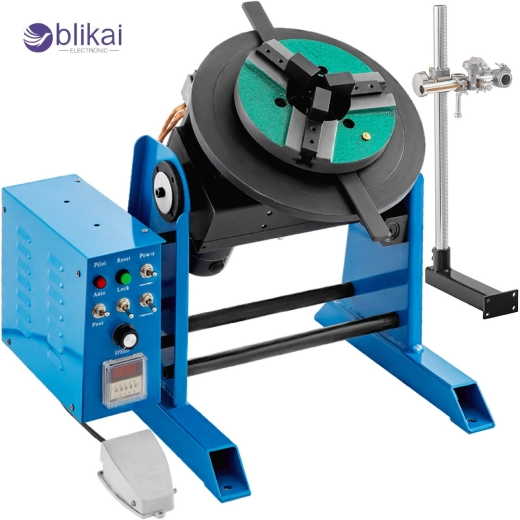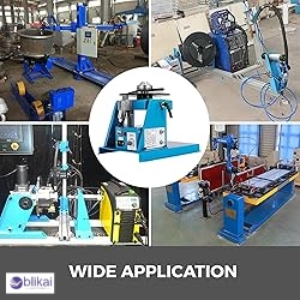What is a Rotary Welding Positioner? [All Explained]
Introduction
Many industries such as automotive, aerospace, construction and shipbuilding, rely heavily on welding during metal fabrication. Thin, smokey or blurry welds may result when handling workpieces that are not uniform or very heavy. When welding, everything is simpler thanks to a rotary welding positioner.
By using a rotary welding positioner, the accuracy of welds is increased since the workpiece moves in steady, controlled rotations and welders do not have to move it manually. This writing covers everything about rotary welding positioners such as their definition, how they function, the types that exist, their advantages, their uses, advice for choosing one and how to maintain them.

What is a Rotary Welding Positioner?
This device is designed to support and rotate a part being welded on a work table. Because the rotary positioner wraps the part around a fixed axis, it allows welders to reach every edge of the workpiece without stopping or rearranging it by hand.
Key Components:
Chuck or Faceplate: This resembles a clamp and holds your workpiece securely. Some positioners allow the jaws to be adjusted or various fixtures to be attached, enabling them to fit different shapes.
Rotary Drive Motor: Powers the rotation of the workpiece, providing smooth, controlled movement.
Control System: Enables the operator to launch, pause, and adjust the rate and direction of rotation. Some controllers are manually adjustable, while others are advanced programmable logic controllers (PLCs) that can be programmed.
Support Structure: The base or frame that provides stability during operation.
How Does a Rotary Welding Positioner Work?
1. Setup: The welder secures the workpiece onto the chuck or faceplate. Such tools may be used to grip circular pipes, metal rings, or any other type of shape.
2. Rotation: A horizontal or vertical axis is used to rotate the workpiece thanks to the motor. The welding robot’s speed is changed depending on its alignment during the process.
3. Welding: When rotating the object, the welder can either position the torch at one spot or let the equipment move and form equally spaced beads on its outside.
4. Control: Because of the control system, the welding process can be stopped, run backward, slowed down or sped up, so operators can maintain a suitable welding speed.
Types of Rotary Welding Positioners
Rotary welding positioners come in various designs tailored to specific welding requirements:
1. Single-Axis Rotary Positioners
Rotate workpieces around one axis only, typically horizontal.
Ideal for simple cylindrical parts such as pipes or tubes.
Compact and cost-effective for basic welding tasks.
2. Dual-Axis Rotary Positioners
Add extra movement, such as tilting or swiveling, to your rotation.
Let welders position their workpieces in the best locations, particularly for complex connections.
Provide aid for weld seams that are hard to access.
3. Tilting Rotary Positioners
Feature a rotary table that can tilt to various angles.
Improve ergonomics by allowing welders to work at comfortable positions.
Useful for welding irregularly shaped or large parts requiring precise angular access.
4. Motorized Tables and Custom Solutions
Integrate programmable controls for fully automated welding processes.
It can be combined with robotic welding arms and automated feeders.
Suitable for high-volume industrial manufacturing where speed and repeatability are critical.
Comparison Table
|
Type |
Movement |
Use Case |
Cost |
|
Single-Axis |
Rotation only |
Basic cylindrical parts |
Low |
|
Dual-Axis |
Rotation + Tilt/Swivel |
Complex welds on irregular parts |
Medium |
|
Tilting |
Rotation + Tilt |
Ergonomic welding access |
Medium-High |
|
Motorized/Custom |
Programmable motion |
Automated high-volume production |
High |
Advantages of Using a Rotary Welding Positioner
Having a rotary welding positioner gives your welding operations several clear advantages:
1. Improved Welding Accuracy and Consistency
Moving the workpiece at a steady rate enables welders to apply predictable beads of weld throughout the weld joint. With this method, stronger welds are achieved without surface blemishes.
2. Enhanced Operator Safety and Ergonomics
Welders can be injured and tired when left to move heavy workpieces on their own. With rotary positioners, you don’t have to rotate the part physically. With tilting models, welders can stand in more relaxing positions during work.
3. Increased Productivity and Efficiency
When rotation is automated or partially automated, fewer minutes are spent between welds, allowing work to be completed more quickly. The result is quicker task completion and reduced labor costs.
4. Ability to Handle Large or Complex Workpieces
Large or awkward pieces that cannot be handled easily can be easily located and rotated to allow welds that would be impossible or unsafe otherwise.
5. Flexibility in Welding Applications
Rotary welding positioners are useful in workshops because they enable MIG, TIG, stick, and plasma welding.
Common Applications of Rotary Welding Positioners
Rotary welding positioners are employed across various industries where precision welding is critical:
Automotive Manufacturing
Used to weld engine components, exhaust pipes, and frames with high repeatability and quality control.
Aerospace Industry
Fundamental for creating aircraft structures that require both high-quality and exact welds.
Construction and Heavy Equipment
Positioning and stability in welding are improved for big steel structures, large pipes and heavy machinery items.
Shipbuilding
With the help of a positioner, it is easier to weld ship sections, pipe assemblies and large parts.
Pipe and Tank Fabrication
When using rotary welding positioners, cylindrical tanks and pipelines allow you to make welds all the way around with minimal effort.

How to Choose the Right Rotary Welding Positioner
It is necessary to think about various things before selecting a rotary welding positioner:
1. Load Capacity
Determine the maximum weight of the workpieces you will be welding. Choose a positioner rated above this limit for safety and durability.
2. Rotation Speed Range
A variable-speed drive allows you to adjust the rotation speed based on welding requirements. Some materials and weld types need slower speeds, while others benefit from faster rotation.
3. Control Type
Manual Controls: Simple and cost-effective but require more operator input.
Semi-Automatic: Combines manual start and stop with programmable speed settings.
Fully Automated: Integrated with PLCs for repeatable, programmable sequences—ideal for mass production.
4. Workpiece Size and Shape
Ensure the chuck or faceplate can accommodate the diameter and shape of your workpiece. Some positioners offer interchangeable chucks or adjustable jaws.
5. Additional Features
Tilting or swiveling capabilities for multi-axis positioning.
Safety features such as emergency stops and overload protection.
Compatibility with robotic welding equipment for automation.
6. Budget and Maintenance
Balance upfront cost with expected productivity gains and maintenance requirements. Higher-end models often have longer service life and lower downtime.
Maintenance and Safety Tips for Rotary Welding Positioners
Well-maintained and safely working rotary welding positioners are likely to last much longer.:
Maintenance Best Practices
Regular Lubrication: Follow manufacturer guidelines for greasing bearings, gears, and moving parts.
Electrical Inspection: Periodically check wiring, switches, and control panels for wear or damage.
Cleanliness: Keep the positioner free of slag, dust, and debris that could impair motion.
Clamp Inspection: Ensure chuck jaws and faceplates maintain strong, secure grip to prevent workpiece slipping.
Calibration: Verify rotation speeds and control settings are accurate.
Safety Tips
Always lock the positioner during workpiece loading and unloading to prevent movement.
Use appropriate personal protective equipment (PPE).
Train operators on emergency procedures and control operations.
Avoid exceeding the load capacity or recommended speed limits.
Maintain a clear workspace around the positioner to avoid accidents.
Conclusion
Advancements in welding perfection, effectiveness and safety can be made with a rotary welding positioner. With the help of a securely held and rotated workpiece, welders can weld further with reduced trouble and can complete a job more efficiently.
FAQ
Q: What is the maximum load capacity of a typical rotary welding positioner?
A: Depending which model you choose, capacities can vary from 220 lbs(100 kg) for small ones to further than several tons for heavy use.
Q: Can rotary welding positioners be used for non-welding tasks?
A: Yes, they're also useful in assembly, examination, machining, and other fabrication tasks taking precise gyration and positioning.
Q: How long does a rotary welding positioner last?
A: Proper keeping of rotary welding positioners enables the utmost of them to last at least 10 times.
Q: Are rotary welding positioners compatible with robotic welding systems?
A: A growing number of ultramodern positioners are compatible with robotic welding and can be managed entirely by automatic control systems.
How Long Do Electrolytic Capacitors Last [Explained]
The Ultimate Guide to CR1220 Battery
What are Audio Transformers for?
Regulated vs Unregulated Power Supply: What's the difference?
Deciphering Variances: Semiconductor vs Microchip vs Integrated Circuit
Circuit Breakers:Types and Applications
What does Comparator Do?
Different Types of Mixers
Differences Between FPGA vs Microcontroller
Transformer Core Faults: Hazards, Causes, Types, Testing, and Remediation










